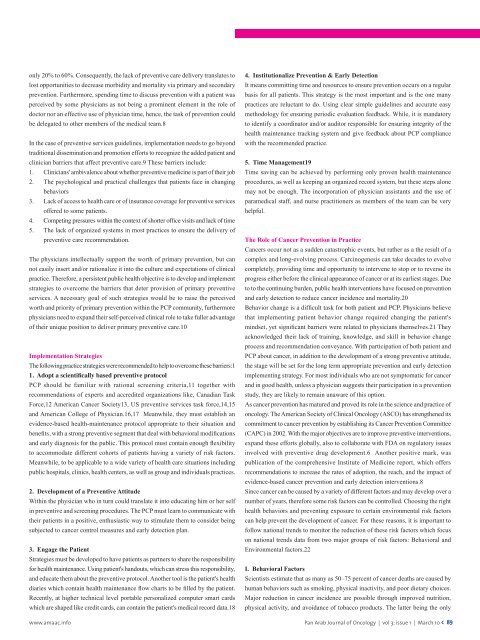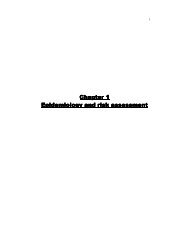Pan Arab Journal of Oncology - Arab Medical Association Against ...
Pan Arab Journal of Oncology - Arab Medical Association Against ...
Pan Arab Journal of Oncology - Arab Medical Association Against ...
Create successful ePaper yourself
Turn your PDF publications into a flip-book with our unique Google optimized e-Paper software.
only 20% to 60%. Consequently, the lack <strong>of</strong> preventive care delivery translates to<br />
lost opportunities to decrease morbidity and mortality via primary and secondary<br />
prevention. Furthermore, spending time to discuss prevention with a patient was<br />
perceived by some physicians as not being a prominent element in the role <strong>of</strong><br />
doctor nor an effective use <strong>of</strong> physician time, hence, the task <strong>of</strong> prevention could<br />
be delegated to other members <strong>of</strong> the medical team.8<br />
In the case <strong>of</strong> preventive services guidelines, implementation needs to go beyond<br />
traditional dissemination and promotion efforts to recognize the added patient and<br />
clinician barriers that affect preventive care.9 These barriers include:<br />
1. Clinicians' ambivalence about whether preventive medicine is part <strong>of</strong> their job<br />
2. The psychological and practical challenges that patients face in changing<br />
behaviors<br />
3. Lack <strong>of</strong> access to health care or <strong>of</strong> insurance coverage for preventive services<br />
<strong>of</strong>fered to some patients.<br />
4. Competing pressures within the context <strong>of</strong> shorter <strong>of</strong>fice visits and lack <strong>of</strong> time<br />
5. The lack <strong>of</strong> organized systems in most practices to ensure the delivery <strong>of</strong><br />
preventive care recommendation.<br />
The physicians intellectually support the worth <strong>of</strong> primary prevention, but can<br />
not easily insert and/or rationalize it into the culture and expectations <strong>of</strong> clinical<br />
practice. Therefore, a persistent public health objective is to develop and implement<br />
strategies to overcome the barriers that deter provision <strong>of</strong> primary preventive<br />
services. A necessary goal <strong>of</strong> such strategies would be to raise the perceived<br />
worth and priority <strong>of</strong> primary prevention within the PCP community, furthermore<br />
physicians need to expand their self-perceived clinical role to take fuller advantage<br />
<strong>of</strong> their unique position to deliver primary preventive care.10<br />
Implementation Strategies<br />
The following practice strategies were recommended to help to overcome these barriers:1<br />
1. Adopt a scientifically based preventive protocol<br />
PCP should be familiar with rational screening criteria,11 together with<br />
recommendations <strong>of</strong> experts and accredited organizations like, Canadian Task<br />
Force,12 American Cancer Society13, US preventive services task force,14,15<br />
and American College <strong>of</strong> Physician.16,17 Meanwhile, they must establish an<br />
evidence-based health-maintenance protocol appropriate to their situation and<br />
benefits, with a strong preventive segment that deal with behavioral modifications<br />
and early diagnosis for the public. This protocol must contain enough flexibility<br />
to accommodate different cohorts <strong>of</strong> patients having a variety <strong>of</strong> risk factors.<br />
Meanwhile, to be applicable to a wide variety <strong>of</strong> health care situations including<br />
public hospitals, clinics, health centers, as well as group and individuals practices.<br />
2. Development <strong>of</strong> a Preventive Attitude<br />
Within the physician who in turn could translate it into educating him or her self<br />
in preventive and screening procedures. The PCP must learn to communicate with<br />
their patients in a positive, enthusiastic way to stimulate them to consider being<br />
subjected to cancer control measures and early detection plan.<br />
3. Engage the Patient<br />
Strategies must be developed to have patients as partners to share the responsibility<br />
for health maintenance. Using patient's handouts, which can stress this responsibility,<br />
and educate them about the preventive protocol. Another tool is the patient's health<br />
diaries which contain health maintenance flow charts to be filled by the patient.<br />
Recently, at higher technical level portable personalized computer smart cards<br />
which are shaped like credit cards, can contain the patient's medical record data.18<br />
4. Institutionalize Prevention & Early Detection<br />
It means committing time and resources to ensure prevention occurs on a regular<br />
basis for all patients. This strategy is the most important and is the one many<br />
practices are reluctant to do. Using clear simple guidelines and accurate easy<br />
methodology for ensuring periodic evaluation feedback. While, it is mandatory<br />
to identify a coordinator and/or auditor responsible for ensuring integrity <strong>of</strong> the<br />
health maintenance tracking system and give feedback about PCP compliance<br />
with the recommended practice.<br />
5. Time Management19<br />
Time saving can be achieved by performing only proven health maintenance<br />
procedures, as well as keeping an organized record system, but these steps alone<br />
may not be enough. The incorporation <strong>of</strong> physician assistants and the use <strong>of</strong><br />
paramedical staff, and nurse practitioners as members <strong>of</strong> the team can be very<br />
helpful.<br />
The Role <strong>of</strong> Cancer Prevention in Practice<br />
Cancers occur not as a sudden catastrophic events, but rather as a the result <strong>of</strong> a<br />
complex and long-evolving process. Carcinogenesis can take decades to evolve<br />
completely, providing time and opportunity to intervene to stop or to reverse its<br />
progress either before the clinical appearance <strong>of</strong> cancer or at its earliest stages. Due<br />
to to the continuing burden, public health interventions have focused on prevention<br />
and early detection to reduce cancer incidence and mortality.20<br />
Behavior change is a difficult task for both patient and PCP. Physicians believe<br />
that implementing patient behavior change required changing the patient's<br />
mindset, yet significant barriers were related to physicians themselves.21 They<br />
acknowledged their lack <strong>of</strong> training, knowledge, and skill in behavior change<br />
process and recommendation conveyance. With participation <strong>of</strong> both patient and<br />
PCP about cancer, in addition to the development <strong>of</strong> a strong preventive attitude,<br />
the stage will be set for the long term appropriate prevention and early detection<br />
implementing strategy. For most individuals who are not symptomatic for cancer<br />
and in good health, unless a physician suggests their participation in a prevention<br />
study, they are likely to remain unaware <strong>of</strong> this option.<br />
As cancer prevention has matured and proved its role in the science and practice <strong>of</strong><br />
oncology. The American Society <strong>of</strong> Clinical <strong>Oncology</strong> (ASCO) has strengthened its<br />
commitment to cancer prevention by establishing its Cancer Prevention Committee<br />
(CAPC) in 2002. With the major objectives are to improve preventive interventions,<br />
expand these efforts globally, also to collaborate with FDA on regulatory issues<br />
involved with preventive drug development.6 Another positive mark, was<br />
publication <strong>of</strong> the comprehensive Institute <strong>of</strong> Medicine report, which <strong>of</strong>fers<br />
recommendations to increase the rates <strong>of</strong> adoption, the reach, and the impact <strong>of</strong><br />
evidence-based cancer prevention and early detection interventions.8<br />
Since cancer can be caused by a variety <strong>of</strong> different factors and may develop over a<br />
number <strong>of</strong> years, therefore some risk factors can be controlled. Choosing the right<br />
health behaviors and preventing exposure to certain environmental risk factors<br />
can help prevent the development <strong>of</strong> cancer. For these reasons, it is important to<br />
follow national trends to monitor the reduction <strong>of</strong> these risk factors which focus<br />
on national trends data from two major groups <strong>of</strong> risk factors: Behavioral and<br />
Environmental factors.22<br />
I. Behavioral Factors<br />
Scientists estimate that as many as 50–75 percent <strong>of</strong> cancer deaths are caused by<br />
human behaviors such as smoking, physical inactivity, and poor dietary choices.<br />
Major reduction in cancer incidence are possible through improved nutrition,<br />
physical activity, and avoidance <strong>of</strong> tobacco products. The latter being the only<br />
www.amaac.info <strong>Pan</strong> <strong>Arab</strong> <strong>Journal</strong> <strong>of</strong> <strong>Oncology</strong> | vol 3; issue 1 | March 10 < 89









